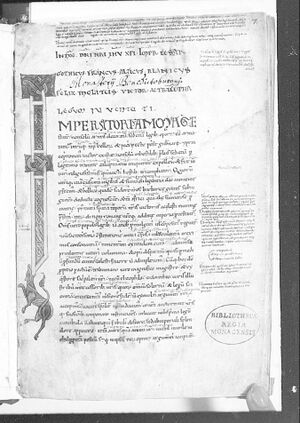München, BSB, Clm 4592
| Library | München, BSB |
|---|---|
| Shelfmark | Clm 4592 |
| Century | saec. XIIex |
| Century 2 | saec. XIII1/2 |
| Century 3 | saec. IX2/4 |
| Provenance | Salzburg |
| Place of origin | Salzburg, Benedikbeuern |
| European region of origin | Central Italy, Southern Germany |
| Collection | Collectio CCL capitulorum |
| Collection 2 | Collectio CCCC capitulorum |
| Collection 3 | Collectio XXX capitulorum |
| Author | Bruno Schalekamp |
| Author | Sven Meeder |
München, Bayerische Staatsbiliothek, Clm 4592 is a composite manuscript of 209 folios. Its three parts were written between the mid-ninth and the early thirteenth centuries. Part I: fols. 1r-75v; part II: 76r-118r; part III: 120r-207v. It was compiled in 1 col. (fols. Iv, 1r-75v, 119v-157v, and 161r-207v) and in 2 cols. (fols. 76ra-118rb, 119ra-vb, and 158ra-161rb), with the following dimensions: I: 185-190 x 85-90 mm in 32-40 lines; II: 180-185 x 100-105 mm in 48-50 lines; III: 190 x 115 mm in 24 lines (235-240 x 160 mm). Its codicological composition reads as follows: 28 quires of which parts I-II were added at a later stage: (V – 1)8 + 2 x (V – 2)24 + 3 x IV47 + (V – 2)54 + (V – 1)63 + (IV – 1)70 + (III – 1)75 + 4 x IV107 + V117 + I119 + (III – 3)122 + (IV – 1)129 + (V – 2)137 + IV145 + (V – 2)153 + 2 x (IV – 2)165 + (VI – 3)174 + V184 + IV192 + (IV – 1)199 + IV207; quire signatures in Roman numerals start at I122 until XII207, foliation in Arabic numerals from the nineteenth century in lead pencil.
Part I was written by one main hand with various later additions by different hands in the margins in late Caroline minuscule; part II was written in three to four hands in Gothic textura; part III was written in one hand in Caroline minuscule. According to Glauche, parts I-II originate from saec. XIIex and XIII1 respectively. Part III was penned in saec. IX2/4 according to Glauche, Kéry, and Mordek. The origins of part I can be traced to central Italy, while II is unknown or possibly from Salzburg according to Glauche. Part III's origins are more clear, according to both Kéry and Mordek, tracing it back to Southeastern Germany, Benediktbeuern. According to Bischoff, the three parts were probably bound together in Salzburg, where the manuscript has remained since, and thus pointing to its provenance from that same place.
Contents

The codex is a large-sized codex consisting of almost exclusively legislative and canonical material. The former is dominated by Justinian's Corpus Iuris Civilis and Bernard of Pavia's Summa decretalium, the latter by the Collectio CCL capitulorum and Collectio CCCC capitulorum. A few chapters of the Collectio XXX capitulorum were incorporated in the former collection. A small excerpt of Bede's De ratione temporum glues both canonical collections together.
The manuscript contains an interesting mix of legal material. The (later) choice to bind the three separate parts together to create a single, cohesive legislative body must have been intentional. As these parts contain, in simple terms, four 'separate' collections of law, one might question why these were considered relevant or complementary to each other. It might be possible some of the laws contradict the contents of the other parts, which begs for more research. Especially part I of the manuscript, furthermore, is filled with stunning illuminations and drawings of, mostly, dogs, as well as many added marginalia. These include both commentaries as well as additions to the main text of various sorts.
Another striking feature is the removal of about two hundred capitula of the Collectio CCL capitulorum in part III, which might have been either intentional or accidental. Was the removal enacted at a much later stage, when the three separate parts were bound together in Salzburg? This would point to an accidental removal; or might we envision an intentional excerption of the capitula, which remains unidentified in another codex or used as fragments at the end of various manuscripts? Such a conclusion would, in any case, point to an interactive and lively transmission of the ninth-century part of the manuscript, possibly indicating continued but limited interest in both the Collectio CCL capitulorum and Collectio CCCC capitulorum.
Most of this description is a reconstruction in concordance with other previous descriptions, catalogues, and academic works. For the digitized version, see: https://www.digitale-sammlungen.de/view/bsb00140154?page=%2C1.
| folios | content |
|---|---|
| Front cover and paper flyleaf | |
| Ir | Note of ownership in an eighteenth-century hand |
| Iv | Short table of contents in a fifteenth-century hand |
| 1r-75v | Justinian I's Corpus Iuris Civilis, Institutes |
| 76ra-118rb | Bernardus Papiensis's Summa decretalium |
| 118v-119v | Blank pages |
| 120ra-157v | Collectio CCL capitulorum, including: |
| 140v-142v: Collectio XXX capitulorum, taken up into collection and untitled | |
| 157v-158r | Short excerpt of Bede's De ratione temporum, chapter 66 |
| 158r-207v | Collectio CCCC capitulorum |
| Back cover |
Literature
Bischoff, Schreibschulen Vol. 1 (1960), p. 46; Bischoff, Schreibschulen Vol. 2 (1980), p. 159; Glauche, Katalog der lateinischen Handschriften (1993), pp. 146-151; Kéry, Canonical Collections pp. 75, 83, and 163; Meeder, 'Biblical past and canonical present: the case of the Collectio 400 capitulorum'; Mordek, Kirchenrecht und Reform pp. 258-259.
The edition of the Collectio CCCC capitulorum by Sven Meeder will soon be in print. Furthermore, an edition of the Collectio XXX capitulorum is currently being prepared by Sven Meeder, Gideon de Jong, and Bruno Schalekamp.
